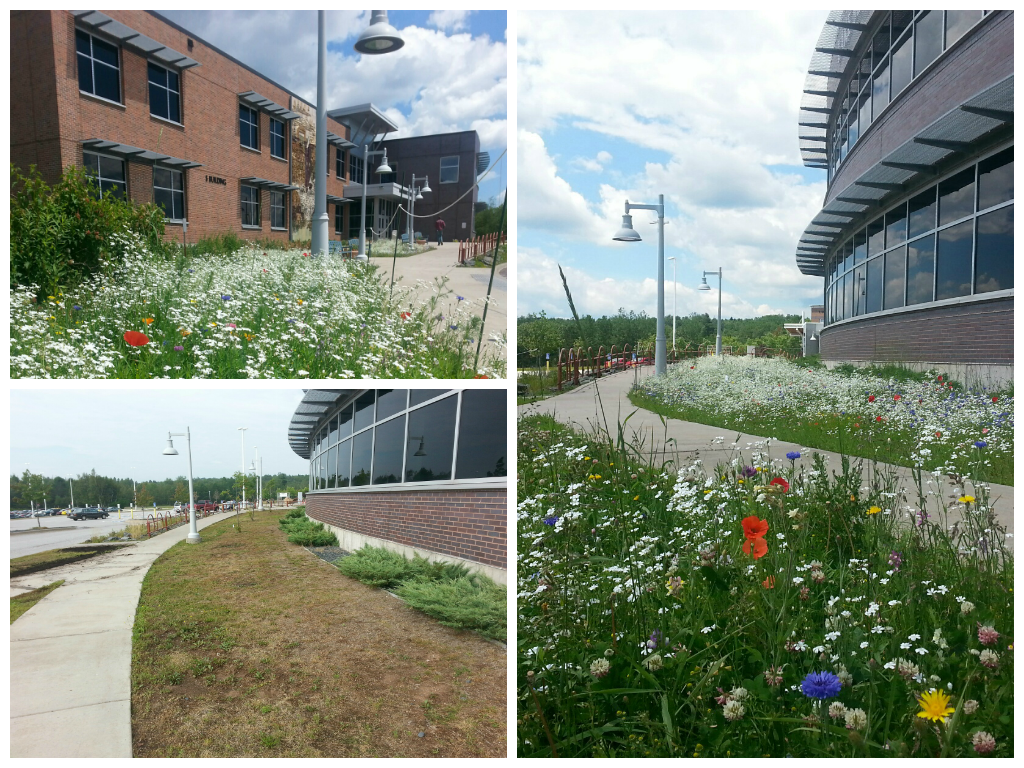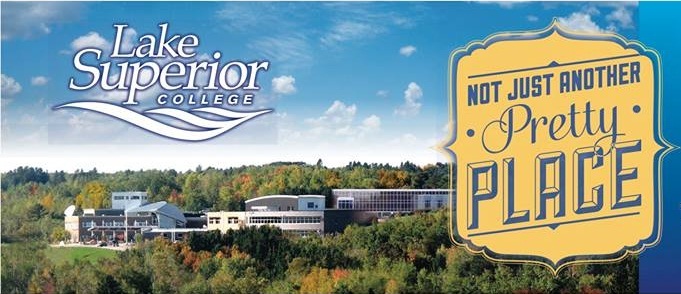Campus Stormwater Management
Stormwater Sensitive Infrastructure
In 2012, LSC’s newest parking lot fix incorporated some major underground stormwater management structures. These structures will slow the flow of water and settle almost 50% of sediment that would otherwise reach Miller Creek through a direct pipe outfall. Reduced sediment to the creek means less chance of increasing stream temperatures of this trout stream. 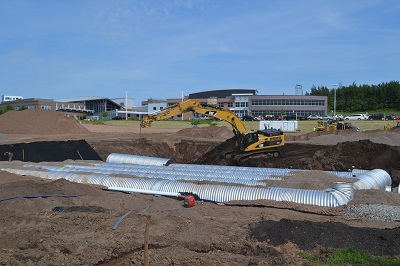 Read more about the design in the LSC Wave article by Mat Gilderman. The parking lot also features energy efficient LED lighting controlled by photoeye technology.
Read more about the design in the LSC Wave article by Mat Gilderman. The parking lot also features energy efficient LED lighting controlled by photoeye technology.
Raingardens, Wildflowers, and Native Grasses
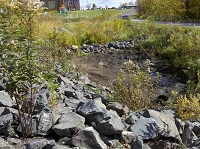 The first raingarden constructed at LSC was a cooperative effort between the college and the South St. Louis County Soil and Water Conservation District. The garden was funded by a $11,000 Clean Water Partnership grant. In 2006, this garden was installed to capture the runoff from the large west parking lot. Because of the volume reaching this garden, it was constructed with a primary entrance point, the forbay, which temporarily holds and settles water and sand. Water then flows into the main water treatment area which is planted with native vegetation. Because of the specific design of this garden, some periodic sand removal from the forbay is required to keep it functioning properly.
The first raingarden constructed at LSC was a cooperative effort between the college and the South St. Louis County Soil and Water Conservation District. The garden was funded by a $11,000 Clean Water Partnership grant. In 2006, this garden was installed to capture the runoff from the large west parking lot. Because of the volume reaching this garden, it was constructed with a primary entrance point, the forbay, which temporarily holds and settles water and sand. Water then flows into the main water treatment area which is planted with native vegetation. Because of the specific design of this garden, some periodic sand removal from the forbay is required to keep it functioning properly.
Visit the SWCD site for more information on Miller Creek restoration projects, including the “Jumbo Gully” project near campus in 2011.
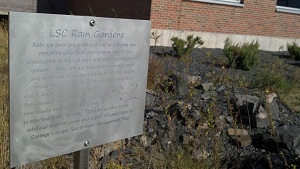 The main entrance raingarden was constructed in 2007 with the Student Services Building addition. The raingarden was installed to capture hillside runoff from the north side of the building through an under-building tunnel.
The main entrance raingarden was constructed in 2007 with the Student Services Building addition. The raingarden was installed to capture hillside runoff from the north side of the building through an under-building tunnel.
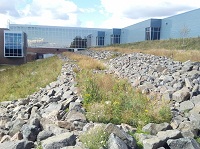 In 2011, LSC’s newest Health and Science Building was constructed uphill from the north side of the main building. The H-Building sits atop a 150 foot vertical decline to Miller Creek. Bio-swales were incorporated into the south facing slope and native grasses are planted to promote infiltration of at least 90% of roof and pavement runoff from an average rainfall event. During initial site preparation, over 1,750 tons of rock were blasted and excavated, and some of the rubble was used in the construction of the terraces. These swales have also proven to be great bedding habitat for deer and their fawns!
In 2011, LSC’s newest Health and Science Building was constructed uphill from the north side of the main building. The H-Building sits atop a 150 foot vertical decline to Miller Creek. Bio-swales were incorporated into the south facing slope and native grasses are planted to promote infiltration of at least 90% of roof and pavement runoff from an average rainfall event. During initial site preparation, over 1,750 tons of rock were blasted and excavated, and some of the rubble was used in the construction of the terraces. These swales have also proven to be great bedding habitat for deer and their fawns!
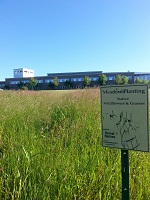 In 2012, after years of planning, the Student Senate Legacy Project kicked-off with a turf kill and initial seeding of about 3,000 square feet of native grasses and wild flowers on the front lawn. The Senate has been working with Boreal Natives, a local division of Prairie Restorations, which specializes in native plant community restoration. They’ve been actively involved in site preparation, planting, and maintenance since the project started. While not a typical rain garden, this area does include a stormwater pipe outlet and wet drainage area. The planting included two different seed mixes; wetland and dry prairie. The grasses will take at least two growing seasons to fully establish, so look for first signs of color and diversity in 2014. The Legacy Project will change and expand each year to include seating areas, walking paths, fruit trees and “adoptable” garden plots in summer 2014!
In 2012, after years of planning, the Student Senate Legacy Project kicked-off with a turf kill and initial seeding of about 3,000 square feet of native grasses and wild flowers on the front lawn. The Senate has been working with Boreal Natives, a local division of Prairie Restorations, which specializes in native plant community restoration. They’ve been actively involved in site preparation, planting, and maintenance since the project started. While not a typical rain garden, this area does include a stormwater pipe outlet and wet drainage area. The planting included two different seed mixes; wetland and dry prairie. The grasses will take at least two growing seasons to fully establish, so look for first signs of color and diversity in 2014. The Legacy Project will change and expand each year to include seating areas, walking paths, fruit trees and “adoptable” garden plots in summer 2014!
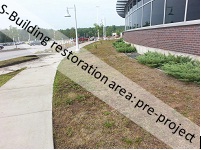 One of LSC’s most visible wildflower area conversions was seeded fall 2013. The campus’ Student Services Building (S-Building) entrance space was converted from typical turf to a low-growing northern climate short grass and wildflower seed mix. This space includes roughly 3,000 combined square feet. The seed mix consists of blue dwarf coneflowers, blue flax, and baby blue eyes along with california poppys, calendula and more. This has been a tricky maintenance area for years, with narrow sidewalks, large snow removal equipment and poor soil, the grass on either side of the sidewalk has had a difficult time thriving. This is the first step in finding a solution that will suit everyone’s needs.
One of LSC’s most visible wildflower area conversions was seeded fall 2013. The campus’ Student Services Building (S-Building) entrance space was converted from typical turf to a low-growing northern climate short grass and wildflower seed mix. This space includes roughly 3,000 combined square feet. The seed mix consists of blue dwarf coneflowers, blue flax, and baby blue eyes along with california poppys, calendula and more. This has been a tricky maintenance area for years, with narrow sidewalks, large snow removal equipment and poor soil, the grass on either side of the sidewalk has had a difficult time thriving. This is the first step in finding a solution that will suit everyone’s needs.
Landscape Planning Process
In 2013, LSC’s Campus Sustainability Council formed a Landscape Planning Work Group. The group’s first task was to develop a landscape planning map. With input from the campus community, our maintenance department and community members, the group will create an annual maintenance plan as well as short- and long-tem planting plans. With well-designed plans, we will mitigate erosion on tricky slopes, reduce stormwater inflow and improve the quality of water flowing to Miller Creek. Additionally, we’ll reduce the need to mow a typical turf grass lawn-scape, and create some areas of interest to invite greater utilization of our outdoor spaces both for education and leisure.
The view from our front lawn includes the St. Louis River estuary and Lake Superior; through Miller Creek, we have a direct connection to both, so we can’t help but be inspired to be great stewards of this land!
Posted in: Good Stuff
Leave a Comment (0) ↓
